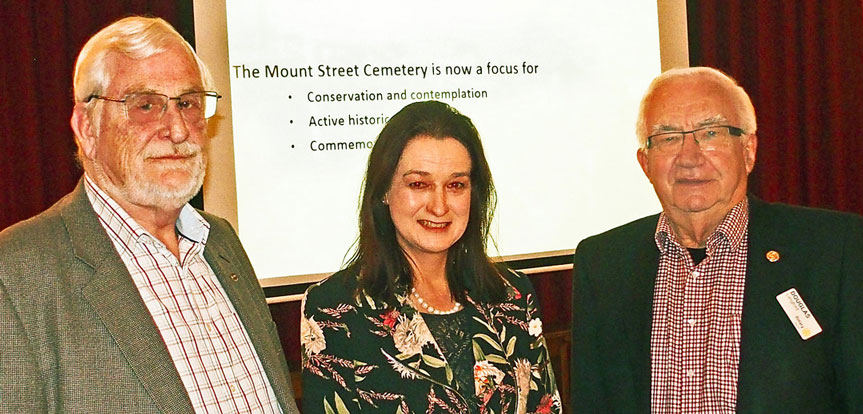
Karen Adair (shown with President Graeme Titcombe and Douglas Langford) addressed Karori Rotarians on the history and current work at the Mount Street Cemetery at their meeting on 22 August.
Karen is a policy manager at the Ministry Of Culture And Heritage. She has a family connection to Rotary Karori through her parents Robin and Yvonne Adair.
Mount Street Cemetery is a little known cemetery adjacent to Waiteata Road in Wellington. Both the Mount Street and Bolton Street cemeteries were created in about 1840 or 1841 and consecrated by Bishop Jean Baptiste Francois Pompellier.
Mount Street Cemetery is the final resting place of a complete cross section of society, and remains church property to this day. The 1840s saw many soldiers buried there, many gold miners were buried there in the 1850s and many Irish Catholics in the 1870s. The earliest surviving headstone belongs to Captain O'Connell and is dated 1850. In total it is estimated that 950 graves are contained in the tiny plot of land.
Mount Street Cemetery was open for about 50 years. The last burial was that of Alice Frost in 1954. The Bolton Street and Karori Cemeteries were then in operation and Mount Street Cemetery fell into a state of disrepair. Nevertheless several attempts have been made to weed and maintain the site, indicating that there are people that still have a family connection to the grave sites.
In 2010 the Friends Of Mount Street Cemetery was formed under the Archdiocese of Wellington. They set about raising funds and consolidating records. The current archaeological work has been carried out by Dr Hans-Dieter Bader of Archaeology Solutions Ltd and funded by the the NZ Lotteries Grants Board.
As a result of the research Karen was able to show us fascinating overlays of the usage of the site at various times. There is still work to be done such as help for descendants to locate burial places, finding the original pathways, tree clearing and replanting etc. It is also hoped to archaeologically preserve memorials and to emphasise the use of the site for historical research and as a centre for contemplation in the middle of the city.